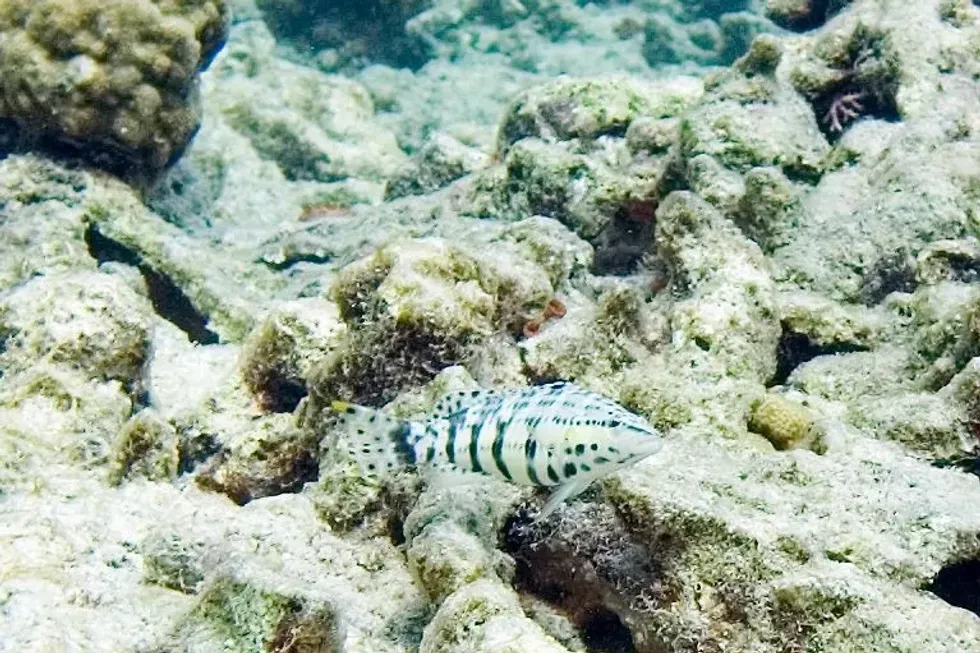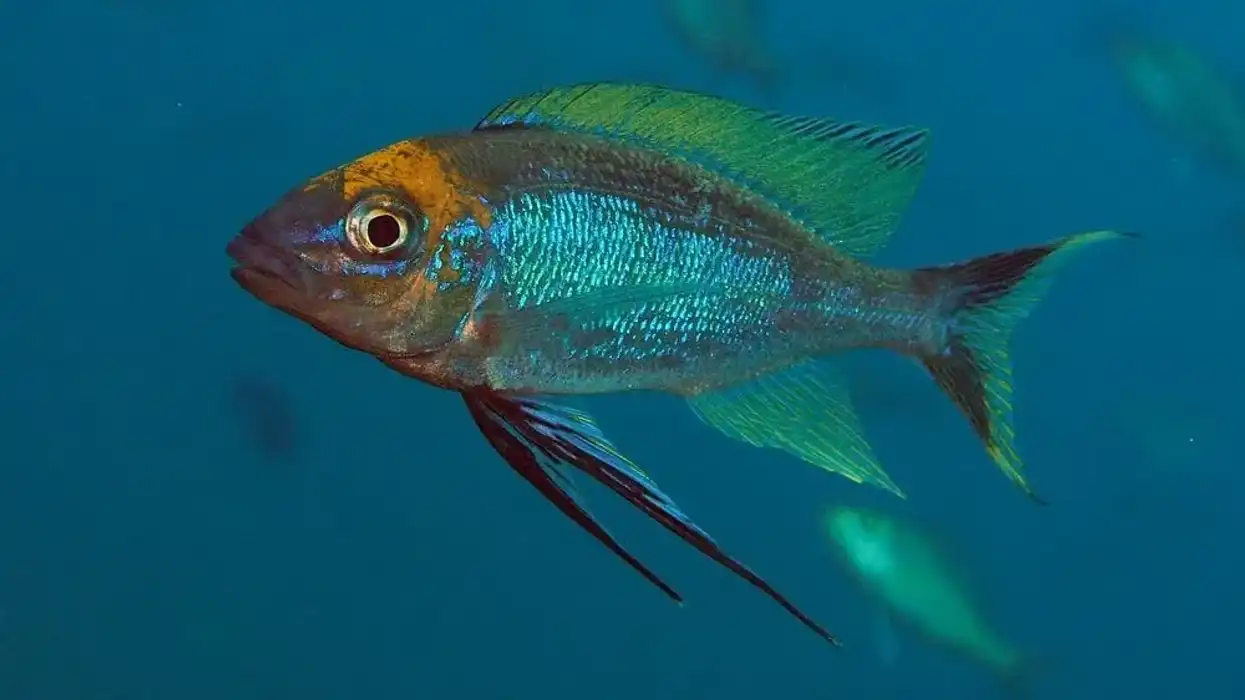The harlequin bass (Serranus tigrinus) is a member of the sea bass or Serranidae family. This species is found in Mexico.
All over the world, there are only 27 species in the genus Serranus, out of which 13 are located in Mexican waters, 10 in the Atlantic, and three in the Pacific Ocean. They can also be found in the Caribbean.
This species is extremely suggested to marine newcomers as it is quite hardy. Their diet consists of frozen foods when in tanks.
The diet for this species also includes small insects, crustaceans, shrimp, and fish in the wild. They have been considered to be reef safe, but the only invertebrates that might bother them include crustaceans as they largely comprise their natural diet.
They are mostly found living among the reef of corals. A 30 gal (136.4 l) aquarium or fish tank with proper hiding areas and corals give these fish the best environment.
They adjust fine to aquarium life and are a very hardy fish that will consume just about any foods given to them. Harlequins are a tiny and important species which makes them compliant in aquariums. The aquarium also needs to have sand material as the fish loves cleaning.
This fish can live with animals that are too large to feed on, however this fish is semi-aggressive and are strong enough to control that aggression. They are only rarely aggressive towards fish that are more prominent than they are.
For more relatable content, check out these humphead wrasse facts and Texas cichlid facts for kids.
Harlequin Bass Interesting Facts
What type of animal is a harlequin bass?
Harlequin bass (Serranus tigrinus) is a species of marine ray-finned fish animal.
What class of animal does a harlequin bass belong to?
This fish belongs to the Actinopterygii class, from the phylum Chordata.
How many harlequin bass fish are there in the world?
There are around 27 species of this fish available in the world. Their total population across the world is unknown. They are reef-safe marine creatures.
Where does a harlequin bass live?
The bass harlequin can be found mostly in tropical waters and even in freshwater and fish tanks. They highly prefer living among the reef of corals to protect themselves against predators that eat them. As aquarium pets, many people have kept them in aquariums or fish tanks in their homes.
What is a harlequin bass's habitat?
This fish can be found in the western Atlantic, North and South America, Europe, the Caribbean, and Africa. They can be found living among the reef of corals undersea. They often eat crustaceans and invertebrates.
Who does harlequin bass fish live with?
They generally live alone, but during the breeding season, they are known to stay in pairs.
How long does a harlequin bass live?
The Serranus tigrinus can live up to five years or more.
How do they reproduce?
The reproduction processes for this species of marine creatures is called simultaneous hermaphroditism. This species shows simultaneous hermaphroditism. This means they have both female and male reproductive organs, as in an ovary and testes. One single fish will lay the eggs while the other fertilizes them during reproduction.
They then will change roles enabling fertilization to take place repeatedly. They do not self-fertilize, and are normally monogamous. They perform to mate, rest, and hunt with only one single fish for their lifespan.
What is their conservation status?
The conservation status of these marine creatures is of Least Concern as they have a stable population.
Harlequin Bass Fun Facts
What do harlequin bass fish look like?
This dwarf seabass fish has a body coloration of white-yellow overall with circular black spots, making tiger-cat streaks on its sides and smaller black points speckling the whole body, dorsal fin, and caudal fin. Their head and body are white dorsally and yellow ventrally.
They have a black line that moves from the front of the nose through to the eye. They have big black blotches on the lower head and throat, two black stripes at the back of the head, and six black stripes on the body.
Their anal spine has a series of black points along its base.
Their caudal spine has a black strip at its base with the scale of the spine being comprised with black points. Their dorsal spine has two series of black points.
The eyes are located above the head, and the nose is long and narrows to form a point. The supreme size for this species is around 4 in (10.2 cm) in length, and they weigh around 1-2 oz (28.3-56.7 g).

How cute are they?
The harlequin bass (Serranus tigrinus) is a very cute and loving animal.
How do they communicate?
It is still unknown how a harlequin bass adult communicates.
How big is a harlequin bass?
They have an overall body size of around 14 in (10.2 cm), which is six times bigger than a golden dwarf barb and five times smaller than a black sea bass.
How fast can a harlequin bass swim?
The swimming speed of this fish is moderate. This species of marine creatures were seen swimming slowly near the ground looking for prey, including small invertebrates like shrimp.
How much does a harlequin bass weigh?
The weight of a bass harlequin is around 1-2 oz (28.3-56.7 g).
What are the male and female names of the species?
Any separate names for the males and females of this species are unknown.
What would you call a baby harlequin bass?
Baby harlequin fish are simply known as fry or larvae.
What do they eat?
They are carnivorous in nature and eat any food with protein. The diet of this marine creature consists of invertebrates like shrimp, frozen foods, crustaceans, and pellets.
Are they aggressive?
The harlequin bass (Serranus tigrinus) is aggressive with other fishes. It will likely live peacefully with tank mates that vary in look and size and don’t interfere too much with its territory. This fish may attack smaller fish. Also, this fish may quarrel with other species and those that strive to occupy the same corner in the fishbowl.
Would they make a good pet?
Yes, they are a good pet as they do not harm humans and are reef safe. Everyone can keep this species as a pet with proper care in a large aquarium or tank with the decoration of corals.
You need to provide proper maintenance of this species of fish in an aquarium. However, one should note that they do not get along with dwarf sea basses or bottom-dwelling fishes.
Did you know...
The harlequin bass has an interesting personality, and they are often known to recognize the aquarist and become tame over time as they are friendly in nature.
Are harlequin bass reef safe?
Yes, this species can be considered reef-safe. Harlequin bass (Serranus tigrinus) are usually peaceful with other related size tank mates, but will be semi-aggressive to others of their kind unless they are a mated pair. They should be single unless a pair is formed.
Are harlequin bass hardy?
Yes, the harlequin bass juvenile (Serranus tigrinus) is extremely hardy and makes a large starter fish for novices. A 30 gal (136.4 l) big aquarium with abundant hiding areas provides a good atmosphere and living space for them. As this species grows, it preys on smaller fish or small crustacean tank mates.
Here at Kidadl, we have carefully created lots of interesting family-friendly animal facts for everyone to discover! Learn more about some other fish from our white cloud mountain minnow fun facts and peacock cichlid facts pages.
You can even occupy yourself at home by coloring in one of our free printable harlequin bass coloring pages.









